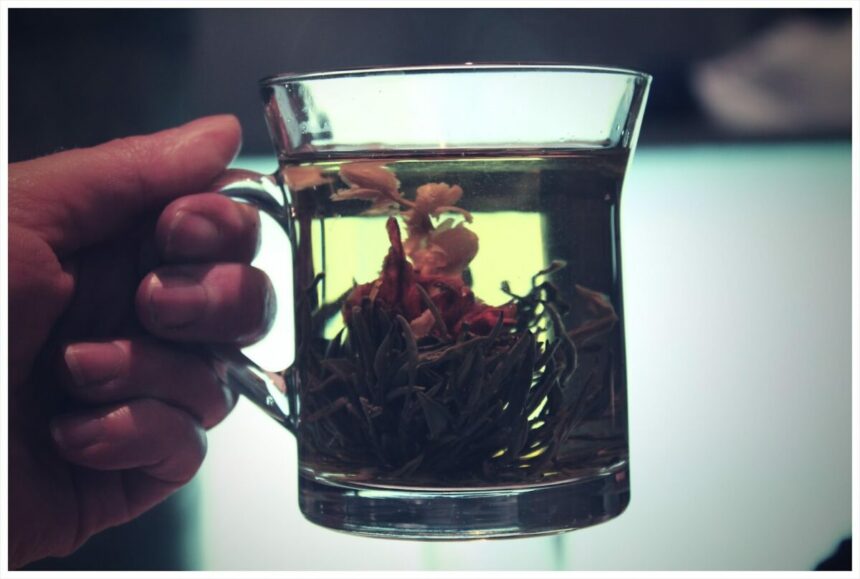
Once, arms waving in frustration, my father said, “If no one’s alive who remembers you, it’s like you never existed.” I was driving him on a trip from his home in North Carolina to the Hudson River Valley, a place Dad had never been but wanted to see. He no longer trusted himself behind the wheel. Alzheimer’s had yet to be diagnosed. When grief hits hard, make a cup of tea. It will get you through. My parents’ ashes now mingle with those of others in their church’s courtyard garden. My favorite tea? Without a doubt: Jasmine Special Grade.
***
Some jasmine teas are just a common leaf with a few jasmine blossoms thrown in. But there are no flowers in Jasmine Special Grade, hence the “Special.” At daybreak, when the jasmine blossoms close, workers harvest the ripest buds and seal them in wooden chests with green tea plucked the previous spring. Tricked open by the cool dark, the flowers infuse the tender leaves with fragrance. The next day, spent blossoms are raked away and the leaves re-scented with another morning’s yield. This coupling and sifting apart is repeated eight times until the tea tinned alone carries the flower’s night bouquet. Remember means to gather what has been scattered.
***
When I can’t find my keys, then discover them in the front door, I worry I have Alzheimer’s. A field pea in a Louisiana parish was christened “Unknown” because no one remembered where it came from. For generations, the Unknown Pea had twined up cornstalks, been cooked with ham hocks, served with collard greens and johnnycakes. Then, in the latter half of the 20th century, it disappeared from parish gardens, compliments, perhaps, of a poor growing season or Winn Dixie convenience. Lost, until a dusty bell jar of pulses was found forgotten in the back of an old farmer’s shed. Now the pea is heirloom, which means something passed down in a family from one generation to another, like a blue vase or the sins of the fathers.
***
Growing up, I learned family history while shelling peas. Women and girls gathered on porches or around kitchen tables, sharing stories to pass the time, hands busy with the day’s take from the market, a pitcher of sweetened iced tea and flyswatter close by. Thumbnails split each seam, spread the pod into wings, spilled the contents—shaped like tiny ears—pat-a-pat-pat into the large mixing bowl, mostly Crowder, sometimes those with more colorful names like Red Ripper or Mississippi Silver. I laughed at the story of Great-Grandma meeting the six children of the one-armed widower she’d just married, pointing at the baby, and saying: “You forgot to tell me about that one!” And listened to tales of “courting” at square dances in the early 20th century. But as a white girl growing up in the South, I wasn’t told the half of it.
Field peas aren’t really peas but beans. They lack tendrils—weaving and spiraling their stems up stakes and trellises instead of grabbing on—prefer hot summers over cooler climes, require long cook times not brief, and come in a variety of shapes and colors, unlike the more uniform round, green pea called garden, sweet, or English. The field pea was brought to the Southeastern United States from West Africa by slave-traders to feed enslaved Africans. Planted on lands the U. S. stole from the Choctaw and Creek, it made its way to the vegetable plots and tables of enslavers.
***
Once, in a hotel lobby, I saw a painted cello. Stippled bands of gold, orange, and purple highlighted the instrument’s womanly curves. A ribbon of white curled up its neck. A series of white cartoon-like horseshoes trotted the cinched waist, then galloped along the bouts. The design gave the cello a bright, happy, and lively appearance. Some say it is the musical instrument that most closely mimics the sound of the human voice, but while this cello, displayed in a plexiglass case, was beautiful to look at, it also was permanently silenced. A cello’s wood needs to vibrate freely in order to make the enchanting low, mournful sound for which it is known, and the artist’s paint created a skin that didn’t allow it to breathe.
***
As a child, I was well schooled in The Lost Cause. Markers, monuments, and textbooks plastered over the South’s true history with tales of beneficent enslavers, happy enslaved, and soldiers fighting for states’ rights. I was grown before I understood nothing was as portrayed.
The Confederate jasmine trained over arbors in the Deep South isn’t really jasmine. The name derives from the vine’s cultivation in the southeast and the sweet scent of its white flowers (which resembles that of my tea). Along with oleander and amsonia, Confederate jasmine is a member of the dogbane family. True jasmine is a member of the olive family.
Even the Mississippi Delta was never a delta, new land formed where a river meets the sea, but an alluvial plain caught between the Yazoo and the Mississippi. Centuries of flood and recede have yielded its rich, dark soil and fields as flat as the upturned palm of a Greenwood debutante pulling on her gloves—opera-length, silk-lined to keep sweat from staining the white kid leather.
And the label on this can of black-eyed peas acknowledges the bean came to the New World from West Africa and has been part of the Southern diet since the 1600s. But it never mentions the enslaved. There are many ways that people disappear.
***
When Dad was diagnosed, afraid of the stigma, my mother and he decided not to let anyone outside of immediate family know he had Alzheimer’s. For a while, he hid it by carefully choosing his words, letting others fill in the gaps.
“And this is my friend . . .” he said once, introducing my husband to a neighbor.
My husband quickly stepping up with, “Nice to meet you, I’m Bob.”
When Dad could no longer cover his memory lapses so easily, my parents cloistered themselves, avoiding gatherings, visits, and phone calls, baffling their friends. For four years, his synapses faded away bit by bit, like fireflies flashing at slower and slower rates as summer cools to fall, until Mom could no longer care for him at home. His obituary didn’t mention his cause of death.
***
I visit my local tea shop about once a month. Before bagging my order, the tea sommelier always tilts the open tin my way so I can catch the comforting fragrance of a field in bloom.
One day, as I enter, she’s sending off a man with, “Thank you, I’ll think about it!”
“A coffee vendor,” she says after the door shuts behind him, wrinkling her nose. “He wants me to sell his product.”
“Are you going to do it?” I ask, surprised.
She throws back her head and laughs, “No way! Every tea in here would smell like java.”
The powerful ability of dried tea to absorb scent makes jasmine tea possible, but also means the leaves must be protected from the taint of unwanted odors.
***
In the town where I now live, two “garden” cemeteries were created in the late 19th century: Hollywood for whites and Evergreen for Blacks. Both were once grand. Hollywood is still elaborate wrought iron, marble statuary, and manicured plots along a winding paved road. Kudzu has veiled thousands of graves in Evergreen for decades. Like a fairytale’s hedge of thorns, the vine’s lush coil and climb, its suggestion of snakes, kept out the Klan during vicious years. Markers with names, dates, and epitaphs safe beneath a thicket of leaves.
***
A quick spit into a plastic tube and a genetic testing company could tell me if I’ve inherited the Alzheimer’s gene. But once you know, you can’t unknow, and there’s no cure. You can’t use herbicides to remove kudzu from cemeteries. Their corrosive ingredients leave stone and masonry pitted and discolored. Kudzu must be removed by raking through the runners and leaves, tracing each vine to its roots, and troweling rhizomes from the clay. Backbreaking work, but the gravestones remain intact. Families can find their kin. Reparation is the act of making amends for an injustice. I just assume I have the gene and live accordingly. Field peas are self-pollinating. They don’t use bees or wind. They cannot change their heritage. Each strain remains what it is, and a single pulse contains a whole family tree.
 Kathy Davis is the author of the poetry collection Passiflora, winner of the 2019 Cider Press Review Book Award and of the chapbook Holding for the Farrier (Finishing Line Press). Her nonfiction work has appeared in Blackbird, Guernica, Solstice Literary Magazine and other journals. She lives with her husband and their pup, Batman, in Rockville, Virginia, where she tends a wildflower meadow when not writing. Finder her online at: http://kathydaviswrites.com.
Kathy Davis is the author of the poetry collection Passiflora, winner of the 2019 Cider Press Review Book Award and of the chapbook Holding for the Farrier (Finishing Line Press). Her nonfiction work has appeared in Blackbird, Guernica, Solstice Literary Magazine and other journals. She lives with her husband and their pup, Batman, in Rockville, Virginia, where she tends a wildflower meadow when not writing. Finder her online at: http://kathydaviswrites.com.
STORY IMAGE CREDIT: fotologic/Flickr Creative Commons



Your conceptual approach reminds me of author Andrea Barrett’s collection of short stories called “Ship Fever” published in 1996.
I’d love to know if you are familiar with this compilation.
Thank you for your marvelous story.
Thank you so much for reading it! I have not read Andrea Barrett’s work but will be sure to check it out.
I love the imagery used in this piece, and the fragmentation you used — I’m a huge fan of fragmented narratives! Also, I really like the contrast between the Kudzu and peas, and the way you accept your heritage at the end, for better or worse. Truly beautiful.
Thank you for your kind comments!
I love the clustering of images, how they are disparate but in the end coalesce. I’m thinking it may be the way the mind works in alzheimers – my MIL has it and I never know where we are when the conversation in her head emerges into speech. The image of the flashing fireflies was devastating. A moving piece.
Thank you Terri! I’m so sorry to hear about your mother-in-law and wish you peace and blessings in your journey with her.
Kathy, Your language is so eloquently simple and stirs me in many ways. I can taste, smell, touch, and see the pictures you paint and relate so well to the people you allow us to meet. Thank you!
Thank you so much Sarah!